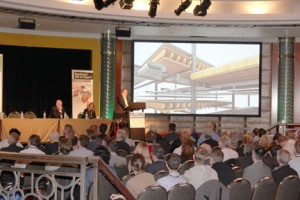Frame 2015, which was held in early June, set the scene for opportunities and ongoing challenges for the industry to move prefab timber construction to a new level of acceptance and participation in Australia’s growing building industry. Source: Timberbiz
This year’s conference, primarily for delegates from building design and construction, was a new event for that market and attracted 250 delegates.
“Our projected attendance was 300 and we reached 250, so for a first time event that was still very good.
“That is also the reason principal supporter of the Frame 2015 event was the WoodSolutions Program, which is a major resource for designers and builders in providing access to information on timber products and technical data to assist in specification,” said conference director Kevin Ezard.
Opening speaker Tony Arnel hit the nail on the head when he said: “timber and engineered wood products are emerging as a sustainable solution for the building industry.
“Project teams are embracing timber and EWP as a renewable building material, and using it to build faster, cheaper and more sustainably than ever before.
“Obviously, the building industry is now giving serious consideration to timber and wood as a viable alternative to steel and concrete construction, due to the changing circumstances for medium density construction in cities and inner urban areas.
“So, the quest is on in earnest to massively increase prefabrication’s share of the Australian construction market in the near future.”
Figures used at the conference were seen as best estimates of the current situation, and it was firmly believed that raising the share from 3% to 10% was not overly ambitious.
The strongest component delivering savings on major construction sites is the ability to use domestic trades to do the work.
The greatest limitation to expanding the amount of work done in this way is the lack of domestic trade workers experienced in prefabricated construction.
Multi-level buildings’ share of the housing market is increasing at a rate that is expected to see it being larger than single unit dwellings by 2030. With prefabrication being the most economic method of construction and timber having numerous advantages over other materials, it stands to reason that timber manufacturers need to ensure they are capable of supplying product into prefabricated construction systems.
Editorial and pictorial coverage of the event is included in the soon-to-be-printed edition of Australasian Timber.
Australasia's home for timber news and information
Building design and construction framed in new conference
11 June 2015
Social Share
Search Timberbiz
CLICK HERE to subscribe to Daily Timber News, the FREE e-new delivered to your inbox 3 times/week with current national and international timber industry news.
Recent Jobs
No job listings found.
Daily Timber News Archives
Subscribe to DTN
Publications
Copyright © 2022 Ryan Media Pty Ltd (Division of Provincial Press Group). All Rights Reserved.






